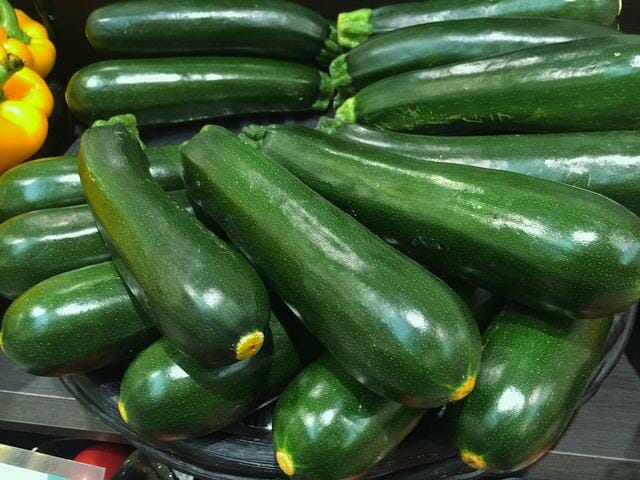Yes, you can freeze zucchini soup for later use. Freezing is a great way to preserve the freshness and flavors of this delicious soup.
Simply let the soup cool completely before transferring it to airtight containers or freezer bags. Leave some space at the top to allow for expansion. Label the containers with the date and freeze them for up to 3 months.
To thaw the frozen soup, simply place it in the refrigerator overnight or defrost it slowly in a saucepan over low heat. Give it a good stir before reheating and enjoy!

Step-by-Step Guide to Freezing Zucchini Soup
If you find yourself with an abundance of zucchini and want to preserve its freshness for later use, freezing zucchini soup is a great option. Whether you’re looking to enjoy the taste of summer during the colder months or simply want to save time in the kitchen, freezing zucchini soup can be a convenient solution. Follow this step-by-step guide to learn how to freeze zucchini soup properly.
Step 1: Prepare the Zucchini Soup
Start by preparing your zucchini soup according to your favorite recipe. Make sure to cook it thoroughly and let it cool completely before moving on to the next step.
Step 2: Portion the Soup
Once the zucchini soup has cooled, portion it into individual serving sizes. This will make it easier to defrost and heat up later. You can use freezer-safe containers or resealable freezer bags. Make sure to leave some headspace in the containers or bags to allow for expansion during freezing.
Step 3: Label and Date
Label each container or bag with the name of the soup and the date it was prepared. This will help you keep track of how long the soup has been frozen and ensure you use it before it loses its quality.
Step 4: Remove Air
If you’re using resealable freezer bags, squeeze out as much air as possible before sealing. This will prevent freezer burn and help maintain the quality of the soup.
Step 5: Freeze
Place the labeled and portioned zucchini soup in the freezer. Make sure to arrange them in a single layer to allow for quick and even freezing. Once frozen, you can stack the containers or bags to save space.
Step 6: Thaw and Reheat
When you’re ready to enjoy the zucchini soup, simply remove it from the freezer and let it thaw in the refrigerator overnight. Once thawed, you can reheat the soup on the stovetop or in the microwave until it reaches your desired temperature. Stir occasionally to ensure even heating.
Step 7: Serve and Enjoy
Once the zucchini soup is heated through, serve it in bowls or mugs and enjoy its delicious flavors. You can garnish it with fresh herbs or a dollop of sour cream for added taste.
In summary, freezing zucchini soup is a convenient method to preserve its freshness and enjoy it later. By following this step-by-step guide, you can ensure that your zucchini soup retains its flavor and quality even after freezing. So, the next time you have an abundance of zucchini, don’t let it go to waste. Freeze it into delicious soup and savor the taste of summer all year round.

Tips for Properly Freezing and Storing Zucchini Soup
When it comes to preserving the delicious flavors of zucchini soup, freezing is an excellent option. Whether you want to save leftovers for future meals or have an abundance of zucchini from your garden, proper freezing and storage techniques will ensure that your zucchini soup remains fresh and flavorful. Here are some tips to help you freeze and store zucchini soup effectively:
1. Cool the Soup
Before freezing, it is important to allow the zucchini soup to cool completely. This helps preserve the texture and flavors of the soup. Place the pot of soup in an ice bath or transfer it to a shallow container to speed up the cooling process. Once the soup has cooled, move on to the next step.
2. Portion into Freezer-Safe Containers
Divide the zucchini soup into individual portions or family-sized servings. This will make it easier to thaw and use only the amount you need without having to defrost the entire batch. Use freezer-safe containers or resealable freezer bags for storage. Make sure to leave some headspace in the containers to allow for expansion during freezing.
3. Label and Date the Containers
It is essential to label each container with the name and date of freezing. This will help you keep track of how long the soup has been stored and ensure that you use the oldest containers first. Use a permanent marker or freezer labels to make the labels easy to read.
4. Remove Air from Containers
If using resealable freezer bags, squeeze out as much air as possible before sealing. Air can lead to freezer burn and negatively affect the quality of the soup. Alternatively, if using containers with lids, press the lids firmly to remove any excess air. This will help maintain the freshness of the soup during freezing.
5. Store in the Freezer
Place the containers of zucchini soup in the freezer. Ensure that they are placed in an upright position to avoid any leakage. Try to leave some space between the containers for proper airflow, allowing for quicker freezing. Remember, the faster the soup freezes, the better the quality will be when thawed.
6. Use within 3-4 Months
Zucchini soup can be safely stored in the freezer for up to 3-4 months. While it is still safe to consume after this period, the quality may deteriorate. Therefore, it is recommended to use the frozen zucchini soup within the specified time frame to enjoy the best flavors.
7. Thawing and Reheating
When you’re ready to enjoy the frozen zucchini soup, there are a few methods for thawing and reheating. The easiest and safest way is to thaw the soup in the refrigerator overnight. Once thawed, simply reheat it on the stovetop or in the microwave until it reaches the desired temperature. Stir the soup occasionally during reheating to ensure even heat distribution.
In summary, freezing and storing zucchini soup can be done effectively by following these tips. Remember to cool the soup completely, portion it into freezer-safe containers, label and date the containers, remove air from containers, store upright in the freezer, use within 3-4 months, and thaw and reheat properly. By taking these steps, you can enjoy the flavors of zucchini soup even when it’s not zucchini season.

How to Thaw and Reheat Frozen Zucchini Soup
If you’ve made a delicious batch of zucchini soup and have leftovers that you’d like to freeze for later, it’s important to know the proper way to thaw and reheat it to preserve its taste and texture. Freezing soup is a great way to have a quick and easy meal on hand whenever you’re in the mood for some comforting zucchini goodness. In this section, we’ll guide you through the steps of thawing and reheating frozen zucchini soup.
Thawing Frozen Zucchini Soup
Thawing frozen zucchini soup is a simple process that requires a little bit of planning ahead. Here’s how you can thaw your frozen soup:
- Transfer the frozen zucchini soup from the freezer to the refrigerator. Allow it to thaw overnight or for approximately 8-12 hours.
- Alternatively, if you’re short on time, you can use the defrost setting on your microwave to thaw the soup. Be sure to follow the manufacturer’s instructions for defrosting soup or use the lowest power setting to prevent overheating.
Reheating Thawed Zucchini Soup
Once your zucchini soup is thawed, it’s time to heat it up and enjoy it. Follow these steps to reheat your thawed zucchini soup:
- Pour the thawed soup into a saucepan or pot.
- Heat the soup over medium heat, stirring occasionally, until it reaches a simmer. Avoid bringing it to a boil, as this can negatively impact the texture of the soup.
- Once the soup is heated through, remove it from the heat and give it a taste. If needed, season with additional salt, pepper, or spices to enhance the flavor.
- Serve the reheated zucchini soup hot and enjoy!
Alternative Reheating Methods
If you’re looking for alternative ways to reheat your frozen zucchini soup, here are a few options:
- Microwave: Transfer the thawed soup into a microwave-safe bowl and heat in the microwave in 1-minute intervals, stirring in between, until it reaches your desired temperature.
- Slow cooker: Pour the thawed soup into a slow cooker and heat on low for 2-3 hours, or until heated through. This method is perfect if you want to have a warm batch of zucchini soup waiting for you after a long day.
- Stovetop steam: Place the frozen soup in a heatproof container and set it on a steamer basket or colander inside a pot with a lid. Add enough water to the pot to create steam, then cover and steam for approximately 15-20 minutes, or until the soup is heated through.
Now that you know how to properly thaw and reheat your frozen zucchini soup, you can enjoy its delicious flavors anytime you crave a bowl of comforting goodness. Whether you choose to thaw it in the refrigerator or use alternative reheating methods, your zucchini soup will be just as tasty and satisfying as the day you made it. Happy cooking!
Creative Ideas for Using Frozen Zucchini Soup
Are you looking for creative ways to use your frozen zucchini soup? Look no further! In this section, we will explore some delicious and innovative ideas that will transform your frozen soup into a variety of mouthwatering dishes. From appetizers to main courses, there are endless possibilities to explore. Let’s dive in!
1. Zucchini Soup Grilled Cheese
Elevate your classic grilled cheese sandwich by adding a twist of zucchini soup. Simply defrost a portion of your frozen zucchini soup and spread it on one side of the bread. Layer your favorite cheese on top and grill it until the cheese is melted and gooey. The result is a comforting and flavorful sandwich that will surely satisfy your taste buds.
2. Zucchini Soup Pasta Sauce
Give your regular pasta sauce a boost of flavor by incorporating frozen zucchini soup. Heat the soup in a saucepan and use it as a base for your pasta sauce. Add in your preferred herbs, spices, and protein of choice. Toss it with cooked pasta, and you’ll have a delicious and creamy pasta dish that is sure to impress.
3. Zucchini Soup Ravioli Filling
Create homemade ravioli with a delectable zucchini soup filling. Defrost your frozen zucchini soup and strain out any excess liquid. Use the thick soup as a filling for your ravioli. Seal the ravioli and cook them according to your preferred method. Serve the ravioli with a complementary sauce, such as a simple garlic butter or a light tomato sauce, for a delightful gourmet meal.
4. Zucchini Soup Bread
Add a unique twist to your homemade bread by incorporating frozen zucchini soup. The soup acts as a flavor enhancer and also keeps the bread moist. Simply replace a portion of the liquid in your usual bread recipe with defrosted zucchini soup. The result is a flavorful and aromatic bread that pairs well with soups, stews, or enjoyed on its own.
5. Zucchini Soup Stuffed Peppers
Transform your frozen zucchini soup into a delicious stuffing for bell peppers. Cut the tops off the peppers and remove the seeds. Fill each pepper with the defrosted zucchini soup and top it with grated cheese. Bake until the peppers are tender and the cheese is melted and golden. This dish makes for a satisfying and wholesome meal that is both visually appealing and packed with flavors.
These are just a few creative ideas to inspire you in using your frozen zucchini soup. Feel free to experiment and adapt these ideas to suit your personal preferences. With a little creativity, you can turn your frozen soup into a culinary masterpiece!
Frequently Asked Questions (FAQs)
Can you freeze zucchini soup?
Yes, you can freeze zucchini soup. It is best to cool the soup completely before transferring it to airtight containers or freezer bags. Leave some space at the top of the container for expansion. Frozen zucchini soup can be stored for up to 3 months. Thaw it in the refrigerator overnight before reheating.
How long can you keep cooked chicken in the refrigerator?
Cooked chicken can be safely stored in the refrigerator for up to 4 days. Make sure to store it in an airtight container to prevent cross-contamination. If you are unsure about the safety of the chicken, check for any signs of spoilage such as a sour smell or unusual texture before consuming.
What is the best way to store fresh herbs?
The best way to store fresh herbs is to treat them like fresh flowers. Trim the stems, place them in a glass or jar filled with water, and cover them loosely with a plastic bag. Keep the herbs in the refrigerator, changing the water every few days. This method can help extend the freshness of the herbs for up to two weeks.
Conclusion
In conclusion, freezing zucchini soup is a convenient way to preserve its delicious flavors and nutritional value for later consumption. By properly storing the soup in airtight containers or freezer bags, you can prolong its shelf life and enjoy it on a busy day when you don’t have time to cook. The process of freezing zucchini soup helps to retain its texture and taste, allowing you to savor the freshness of the ingredients even after thawing. Whether it’s a homemade zucchini soup or a store-bought variety, freezing is an excellent option to prevent wastage and ensure a ready-to-eat meal whenever you need it.
Freezing zucchini soup is particularly beneficial when you have an abundance of zucchini or when you want to extend the longevity of the soup for future use. It allows you to enjoy the flavors of summer even during the colder months and simplifies meal planning. So, go ahead and freeze your zucchini soup to make your life easier and always have a comforting bowl of goodness just a thaw away.

